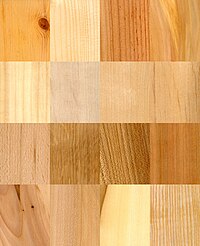
Photo from wikipedia
During industrial wood drying, extractives migrate towards the wood surfaces and make the material more susceptible to photo/biodegradation. The present work provides information about the distribution, quantity and nature of… Click to show full abstract
During industrial wood drying, extractives migrate towards the wood surfaces and make the material more susceptible to photo/biodegradation. The present work provides information about the distribution, quantity and nature of lipophilic substances beneath the surface in air- and kiln-dried Scots pine (Pinus sylvestris L.) sapwood boards. Samples were taken from knot-free sapwood surfaces and the composition of lipophilic extractives, phenols and low-molecular fatty/resin acids layers at different nominal depths below the surface was studied gravimetrically, by UV-spectrometry and by gas chromatography-mass spectrometry (GC-MS). The concentration of total extractives was significantly higher in kiln-dried than in air-dried samples and was higher close to the surface than in the layers beneath. The scatter in the values for the lipophilic extractives was high in both drying types, being highest for linoleic acid and slightly lower for palmitic, oleic and stearic acids. The amount of fatty acids was low in kiln-dried boards, probably due to a stronger degradation due to the high temperature employed. The most abundant resin acid was dehydroabietic acid followed by pimaric, isopimaric, and abietic acids in both drying types. It is concluded that during kiln-drying a migration front is created at a depth of 0.25 mm with a thickness of about 0.5 mm.
Journal Title: PLoS ONE
Year Published: 2018
Link to full text (if available)
Share on Social Media: Sign Up to like & get
recommendations!